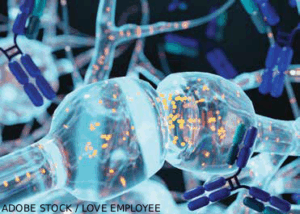 CHICAGO—At this year’s ACR Convergence, Shaun Jackson, MD, PhD, gave the Dubois Memorial Lecture, named for Edmund L. Dubois, MD, a pioneer in systemic lupus erythematosus (SLE) research. Dr. Jackson, an attending physician in pediatric rheumatology and nephrology and principal investigator at Seattle Children’s Hospital Research Institute’s Center for Immunity and Immunotherapies, spoke on the evolving understanding of the role of B cells in SLE, with insights on related therapeutic and research questions.
CHICAGO—At this year’s ACR Convergence, Shaun Jackson, MD, PhD, gave the Dubois Memorial Lecture, named for Edmund L. Dubois, MD, a pioneer in systemic lupus erythematosus (SLE) research. Dr. Jackson, an attending physician in pediatric rheumatology and nephrology and principal investigator at Seattle Children’s Hospital Research Institute’s Center for Immunity and Immunotherapies, spoke on the evolving understanding of the role of B cells in SLE, with insights on related therapeutic and research questions.
Role of B Cells in SLE
Rheumatology interest in B cells in SLE pathophysiology goes back several decades. Researchers hoped that a 2012 phase 3 lupus nephritis study of rituximab, a B cell–depleting anti-CD20 monoclonal antibody, would yield a new therapeutic option; however, the heavily publicized trial failed.1 Dr. Jackson, then early in his work studying the role of B cells in lupus nephritis, remarked that this wasn’t a very auspicious start to his career.
The reasons for the trial’s failure were probably multifaceted, with other trials showing some mixed success; many rheumatologists still used the therapy off label, especially for non-responsive or severe disease.2 It’s now thought that the somewhat poor response of such B cell–depleting therapies in many autoimmune diseases may be due to the persistence of autoreactive B cells outside the blood, in lymphatic tissues or other organs.3

Dr. Shaun W. Jackson
“Things have changed enormously over the last 12 or 13 years,” said Dr. Jackson. He pointed to the U.S. Food & Drug Administration’s approval of obinutuzumab, another anti-CD20 B cell–depleting monoclonal antibody, in October 2025. He also emphasized the recent transformative work on the power of B cell depletion in the context of chimeric antigen receptor (CAR) T cell therapy, pioneered in human subjects by Georg Schett, MD, a rheumatologist at the University Hospital Erlangen, Germany.3,4
Mouse Models
Dr. Jackson traced developments in understanding B cells in SLE through a series of studies in mouse models. For example, he showed how knocking out certain genes in B cells alone could either significantly promote SLE or protect against it, depending on the gene involved, e.g., those linked to toll-like receptors 7 and 9, interferon γ, interleukin (IL)-6 and nicotinamide adenine dinucleotide phosphate (NADPH) oxidase.5-9
“There’s a central role for dysregulated signaling [in SLE], particularly on the B cell receptor, toll-like receptors and cytokine receptor pathways, which seem to be very important for the initiation of lupus,” Dr. Jackson said. He noted that although immunology textbooks often illustrate T cells finding B cells, B cells may play more of the central role in orchestrating breaks in T cell tolerance, perhaps by helping concentrate antigens for presentation to T cells.
Human Studies
Dr. Jackson further shared how he and others in the field began to study B cell mechanisms in lupus nephritis through human studies. It was challenging to make this move because they were attempting to understand the role of B cells in lupus nephritis on a very mechanistic level. They began to make progress with a new technique, single cell resolution spatial transcriptomics, which allowed them to visualize specific RNA molecules in cells in kidney samples from controls and from children with lupus nephritis.10
“The spatial data seem to imply that there’s a role for an ongoing adaptive immune response in lupus nephritis, and, at least based on what we see, the activated B cells seem to be at the center of that,” shared Dr. Jackson. He noted that this data mirrored what they’d seen in animal models on the key role for B cells in orchestrating the immune response.
Circling back to the question of rituximab’s failure, Dr. Jackson discussed a case report of a refractory pediatric patient with lupus nephritis. On biopsy, Dr. Jackson and colleagues found that the patient’s kidneys were full of B cells and plasma cells post-rituximab treatment, even when her blood levels of B cells were undetectable. “That implied that one of the reasons why rituximab was not working was because it doesn’t deplete B cells very well in the secondary lymphoid organs, and in this case, the [kidney] as well,” he explained.
CAR T Cell Therapy
This finding is consistent with Dr. Schett et al.’s paradigm-shifting work with CAR T cell therapy. Instead of depleting B cells via a monoclonal antibody, an individual’s T cells are removed and then genetically modified to target the CD19 antigen (naturally occurring on B cells). After chemotherapy, infusion with the modified T cells has resulted in profound depletion of circulating B cells, with much greater reductions in B cells in lymphoid tissue compared with rituximab. This approach has yielded remarkable patient outcomes that have been sustained in some patients for many months, even after the B cells repopulate.3,4
Seattle Children Hospital is also pursuing the first U.S. CAR T cell trial for children with lupus in their ongoing REACT-01 trial (Reversing Autoimmunity through Cell Therapy). Initial results have been encouraging, Dr. Jackson noted. Their first patient, who has successfully come off immunosuppressive therapies, reports feeling remarkably better; her laboratory markers are much improved, although she may have sustained some degree of permanent kidney damage during her long and refractory disease course.
Looking forward, Dr. Jackson stated that he believes that the field will explore multiple avenues of CAR T cell therapy. Initial work has used autologous CAR T cells, but Dr. Jackson pointed out the potential utility of using allogenic CAR T cells. Scientists are also pursuing such work as engineering natural killer cells instead of T cells (CAR NK), generating CAR T cells and NK cells from induced pluripotent stem cells, finding ways to deliver CAR T in vivo (without removal of the patient’s T cells) and using T cell engagers, a kind of bispecific monoclonal antibody.
Dr. Jackson said that most CAR T cell trials in SLE focus on CD19 as a target. However, his lab is also exploring B cell maturation antigen (BCMA), a marker that is highly expressed on plasma cells. For certain autoimmune diseases, targeting BCMA might be important to deplete pathogenic long-lived plasma cells in the bone marrow, which are not eliminated by CD19-directed therapies.
Dr. Jackson emphasized that although identifying the optimal cell target must be validated in human clinical trials, the next decade promises exciting advances in the treatment of lupus and other humoral autoimmune diseases. Researchers aiming to change the paradigm for these diseases with CAR therapies will need to explore not just different modalities, but also alternative targets like BCMA, he urged.
Ruth Jessen Hickman, MD, a graduate of the Indiana University School of Medicine, is a medical and science writer in Bloomington, Ind.
References
- Rovin BH, Furie R, Latinis K, et al. Efficacy and safety of rituximab in patients with active proliferative lupus nephritis: The Lupus Nephritis Assessment with Rituximab study. Arthritis Rheum. 2012 Apr;64(4):1215–1226.
- Mo S, Li Y, He J, Lin L. Progress of rituximab in the treatment of systemic lupus erythematosus and lupus nephritis. Front Med (Lausanne). 2024 Oct 4;11:1472019.
- Schett G, Mackensen A, Mougiakakos D. CAR T-cell therapy in autoimmune diseases. Lancet. 2023 Nov 25;402(10416):2034–2044.
- Mackensen A, Müller F, Mougiakakos D, et al. Anti-CD19 CAR T cell therapy for refractory systemic lupus erythematosus. Nat Med. 2022 Oct;28(10):2124–2132.
- Jackson SW, Scharping NE, Kolhatkar NS, et al. Opposing impact of B cell-intrinsic TLR7 and TLR9 signals on autoantibody repertoire and systemic inflammation. J Immunol. 2014 May 15;192(10):4525–4532.
- Jackson SW, Jacobs HM, Arkatkar T, et al. B cell IFN-γ receptor signaling promotes autoimmune germinal centers via cell-intrinsic induction of BCL-6. J Exp Med. 2016 May 2;213(5):733–750.
- Arkatkar T, Du SW, Jacobs HM, et al. B cell-derived IL-6 initiates spontaneous germinal center formation during systemic autoimmunity. J Exp Med. 2017 Nov 6;214(11):3207–3217.
- Liu S, Lagos J, Shumlak NM, et al. NADPH oxidase exerts a B cell-intrinsic contribution to lupus risk by modulating endosomal TLR signals. J Exp Med. 2024 Apr 1;221(4):e20230774.
- Gordon RA, Cosgrove HA, Marinov A, et al. NADPH oxidase in B cells and macrophages protects against murine lupus by regulation of TLR7. JCI Insight. 2024 Jul 23;9(16):e178563.
- Danaher P, Hasle N, Nguyen ED, et al. Childhood-onset lupus nephritis is characterized by complex interactions between kidney stroma and infiltrating immune cells. Sci Transl Med. 2024 Nov 27;16(775):eadl1666.
